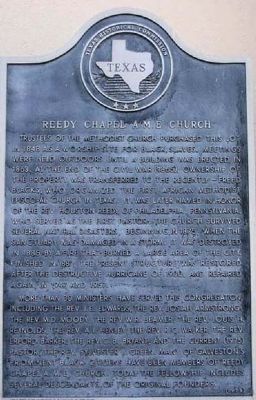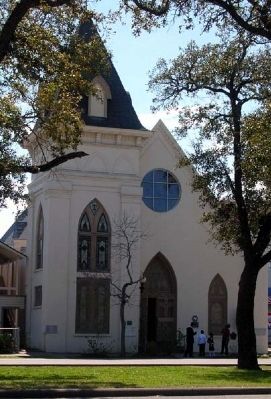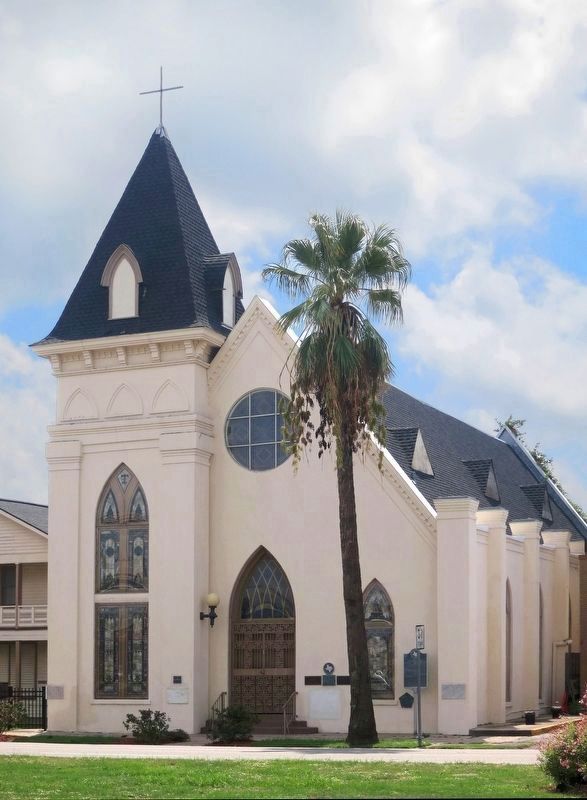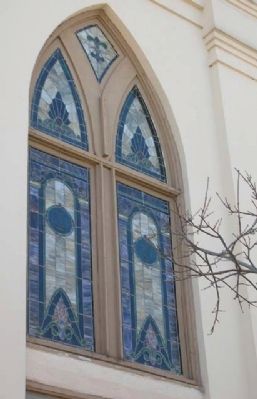Galveston in Galveston County, Texas — The American South (West South Central)
Reedy Chapel A.M.E. Church
More than 30 ministers have served the congregation including the Rev. J.E. Edwards, the Rev. Josiah Armstrong, the Rev. M.D. Moody, The Rev. W.R. Beamer, the Rev Louis H. Reynolds, the Rev. A.I. Henley, the Rev. R.C. Walker, the Rev. Erford Barker, the Rev. C.B. Bryant, and The Rev. Sylvester I. Green. Many of Galveston's prominent Black citizens have been members of Reedy Chapel A.M.E. Church. Today the fellowship includes several descendants of the original founders.
Erected 1975 by Texas Historical Commission. (Marker Number 7549.)
Topics and series. This historical marker is listed in these topic lists: African Americans • Churches & Religion. In addition, it is included in the African Methodist Episcopal (AME) Church series list. A significant historical year for this entry is 1848.
Location. 29° 18.039′ N, 94° 47.337′ W. Marker is in Galveston, Texas, in Galveston County. Marker is on Broadway Street (State Highway 87) just west of 21st Street, on the right when traveling east. Located on the south-west corner of Broadway and 21st Street. Touch for map. Marker is at or near this postal address: 2015 Broadway, Galveston TX 77550, United States of America. Touch for directions.
Other nearby markers. At least 8 other markers are within walking distance of this marker. A different marker also named Reedy Chapel A.M.E. Church (a few steps from this marker); J. Levy & Bro. (about 500 feet away, measured in a direct line); St. Joseph's Church (about 700 feet away); Congregation B'nai Israel Synagogue (about 800 feet away); J.F. Smith House (approx. 0.2 miles away); The Galveston Movement (approx. 0.2 miles away); Sonnentheil Home (approx. 0.2 miles away); Confederate Mariner: Leon Smith (approx. 0.2 miles away). Touch for a list and map of all markers in Galveston.
Regarding Reedy Chapel A.M.E. Church.
Reedy Chapel, African Methodist Episcopal Church, Established 1848
Celebrating the 165th Church Anniversary, 2015 Broadway, Galveston, Texas
In 1848 the parishioners and trustees of Galveston’s Methodist Episcopal Church South decided to establish a church for their slaves under the Methodist Episcopal Bishop. On March 18 the trustees purchased property at Broadway and 20th Street and erected a church and a parsonage that became the new home of what was then called the “Negro Methodist Episcopal Church South.” In 1866, the Negro Methodist Episcopal Church was recognized as the first African Methodist Episcopal Church in Texas by the Reverend M.M. Clark and the following year it was turned over to its African-American membership by the Methodist Episcopal trustees on March 18, 1867. The name Reedy Chapel honors Reverend Houston Reedy, who succeeded Clark as the congregation’s second pastor in 1870.
Reedy Chapel is highly recognized for the building’s impressive architecture, but the Church is equally recognized for the significant role it played in the freedom of slaves in Texas. On June 19, 1865, Major General Gordon Granger issued a series of orders for the military occupation of Galveston. The most important of these was No. 3:
The people are informed that, in accordance with a proclamation from the Executive of the United States, all slaves are free.
On January 1, 1866, a large group of newly-freed slaves---men, women and children---walked from Galveston’s old courthouse on 21st and Ball to Reedy Chapel on 20th and Broadway to recognize and celebrate slavery's end. In that historically-significant moment, a proud people chose Reedy Chapel AME Church as the site of the nation's first celebration of the Executive Order issued on June 19, 1865, a celebration of freedom that came to be known as “Juneteenth”.
The first church building was lost to the great fire of 1885 that consumed forty square blocks of Galveston’s east end. The existing Reedy Chapel was built the following year during the pastorate of the Reverend J. E. Edwards. E.F. Campbell was the contractor and the masonry was laid by the renowned Norris Wright Cuney, a Reedy parishioner. The building, designed by Benjamin G. Chisholm, combines gothic revival architecture with regional craftsmanship and is distinguished by the pyramid-roofed tower rising out of its body; the steeply pitched roof consists of a heavy timber scissor truss framing system.
The sanctuary features an arched ceiling of polished wood enhanced and supported by decorative beams. The 1876 Hook and Hastings tracker action pipe organ with its High Victorian Gothic case was sold by Trinity Episcopal Church in about 1912. Reedy Chapel purchased the organ from Gorgan Music for $100; it is one of only two organs of this type in the country.
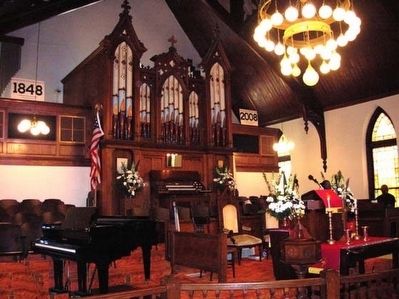
Photographed By SB Gillins
4. Reedy Chapel Pulpit with 1876 Hook and Hastings Pipe Organ
One of only two organs of its type in the country, the other is held by the Smithsonian Institution. The pulpit also includes antique pastors' chairs, hand-crafted altar rail, baptismal font and matching lectern.
Credits. This page was last revised on November 14, 2019. It was originally submitted on March 9, 2008. This page has been viewed 3,974 times since then and 74 times this year. Last updated on February 25, 2013, by SB Gillins of Galveston, Texas. Photos: 1, 2. submitted on March 9, 2008, by SB Gillins of Galveston, Texas. 3. submitted on November 13, 2019, by Jim Evans of Houston, Texas. 4, 5. submitted on March 10, 2008, by SB Gillins of Galveston, Texas. • Bill Pfingsten was the editor who published this page.
